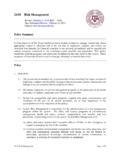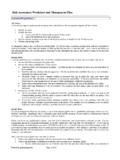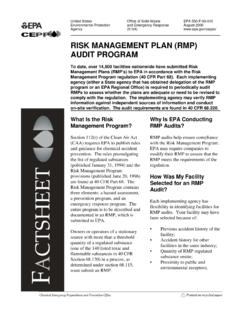Transcription of DIR 138 - Risk Assessment & Risk Management …
1 Risk Assessment and Risk Management plan for DIR 138 Commercial release of canola genetically modified for dual herbicide tolerance and a hybrid breeding system (InVigor x TruFlex Roundup Ready ) Applicant: Bayer CropScience Pty Ltd March 2016 PAGE INTENTIONALLY LEFT BLANKDIR 138 Risk Assessment and Risk Management plan (March 2016) Office of the Gene Technology Regulator Summary of the Risk Assessment and Risk Management plan for Licence Application No. DIR 138 Decision The Gene Technology Regulator (the Regulator) has decided to issue a licence for this application for the intentional, commercial scale release of herbicide tolerant genetically modified (GM) canola in Australia. A Risk Assessment and Risk Management plan (RARMP) for this application was prepared by the Regulator in accordance with requirements of the Gene Technology Act 2000 (the Act) and corresponding state and territory legislation, and finalised following consultation with a wide range of experts, agencies and authorities, and the public.
2 The RARMP concludes that this commercial release poses negligible risks to human health and safety and the environment and no specific risk treatment measures are proposed. However, general licence conditions have been imposed to ensure that there is ongoing oversight of the release. The application Application number DIR 138 Applicant Bayer CropScience Pty Ltd (Bayer) Project title Commercial release of canola genetically modified for dual herbicide tolerance and a hybrid breeding system (InVigor x TruFlex Roundup Ready )1 Parent organism Brassica napus L. (canola) Introduced genes and modified traits phosphinothricin acetyl transferase (bar) gene derived from the bacterium Streptomyces hygroscopicus (tolerance to herbicide glufosinate) 5- enolpyruvylshikimate-3- phosphate synthase (cp4 epsps) gene derived from the bacterium Agrobacterium sp.
3 Strain CP4 (tolerance to herbicide glyphosate) ribonuclease (barnase) gene derived from the bacterium Bacillus amyloliquefaciens (confers male sterility) ribonuclease inhibitor (barstar) gene derived from the bacterium B. amyloliquefaciens (restores fertility) antibiotic resistance gene (nptII) from E. coli ( antibiotic resistance for selection during initial development) Proposed locations Australia-wide, in all canola growing areas Primary purpose Commercial release of the GM c anola 1 The title of the licence application submitted by Bayer is Commercial release of InVigor x TruFlex Roundup Ready (Brassica napus) for use in the Australian cropping system . Summary i DIR 138 Risk Assessment and Risk Management plan (March 2016) Office of the Gene Technology Regulator Risk Assessment The risk Assessment concludes that there are negligible risks to the health and safety of people, or the environment, from the proposed release.
4 The risk Assessment process considers how the genetic modification and activities conducted with the GMOs might lead to harm to people or the environment. risks were characterised in relation to both the seriousness and likelihood of harm, taking into account information in the application, relevant previous approvals, current scientific knowledge and advice received from a wide range of experts, agencies and authorities consulted on the preparation of the RARMP. Both the short and long term impact were considered. Credible pathways to potential harm that were considered included: toxic and allergenic properties of the GM canola; increased spread and persistence leading to increased weediness of the GM canola relative to unmodified plants; and vertical transfer of the introduced genetic material to other sexually compatible plants.
5 The principal reasons for the conclusion of negligible risks are: the introduced proteins are not considered toxic or allergenic to people and other desirable organisms; the parental GM canola lines and other GM crops containing the introduced genes have a history of safe use in Australia and overseas; the introduced genes and proteins are widespread in the environment; the GM canola lines and their progeny can be controlled using integrated weed Management ; the GM canola lines are susceptible to the biotic or abiotic stresses that normally restrict the geographic range and persistence of canola; and the limited capacity of the GM canola to spread and persist in undisturbed natural habitats. In addition, food made from the GM canola is approved by Food Standards Australia New Zealand as safe for human consumption. Risk Management The risk Management plan describes measures to protect the health and safety of people and to protect the environment by controlling or mitigating risk.
6 The risk Management plan is given effect through licence conditions. As the level of risk is assessed as negligible, specific risk treatment is not required. However, the Regulator has imposed licence conditions to ensure that there is ongoing oversight of the release and to allow the collection of information to verify the findings of the RARMP. The licence also contains a number of general conditions relating to ongoing licence holder suitability, auditing and monitoring, and reporting requirements, which include an obligation to report any unintended effects. Summary ii DIR 138 Risk Assessment and Risk Management plan (March 2016) Office of the Gene Technology Regulator Table of contents SUMMARY OF THE RISK Assessment AND RISK Management plan .. I DECISION .. I THE APPLICATION .. I RISK Assessment .. II RISK Management .. II TABLE OF CONTENTS.
7 III ABBREVIATIONS .. V CHAPTER 1 RISK Assessment CONTEXT .. 1 SECTION 1 BACKGROUND .. 1 SECTION 2 REGULATORY FRAMEWORK .. 1 SECTION 3 THE PROPOSED RELEASE .. 2 SECTION 4 PREVIOUS RELEASES OF THE GM CANOLA PROPOSED FOR RELEASE AND OTHER RELEVANT GM CANOLA .. 3 Australian approvals .. 3 Approvals by other Australian agencies .. 4 International approvals .. 4 SECTION 5 THE PARENT ORGANISM .. 5 Potential to cause harm .. 5 Invasiveness .. 6 Actual distribution .. 6 SECTION 6 THE PARENTAL GM CANOLA LINES AND OTHER RELEVANT GM CANOLA .. 6 The introduced genetic material and its effects .. 7 Toxicity/allergenicity of the parental GM canola lines .. 13 Method of genetic modification of the parental GM canola lines .. 15 Weediness of the parental GM canola lines .. 15 SECTION 7 THE GMOS PROPOSED FOR RELEASE .. 16 Introduction to the GMOs.
8 16 Characterisation of the GMOs .. 17 SECTION 8 THE RECEIVING ENVIRONMENT .. 24 Relevant agronomic practices .. 25 Relevant abiotic factors .. 25 Relevant biotic factors .. 26 Presence of the introduced or similar genes and proteins in the receiving environment .. 27 CHAPTER 2 RISK Assessment .. 29 SECTION 1 INTRODUCTION .. 29 SECTION 2 RISK IDENTIFICATION .. 30 Risk source .. 30 Causal pathway .. 31 Potential harm .. 33 Postulated risk scenarios .. 33 SECTION 3 UNCERTAINTY .. 44 SECTION 4 RISK EVALUATION .. 45 CHAPTER 3 RISK Management plan .. 47 SECTION 1 BACKGROUND .. 47 SECTION 2 RISK TREATMENT MEASURES FOR SUBSTANTIVE risks .. 47 Table of Contents iii DIR 138 Risk Assessment and Risk Management plan (March 2016) Office of the Gene Technology Regulator SECTION 3 GENERAL RISK Management .. 47 Applicant suitability.
9 47 Testing methodology .. 48 Identification of the persons or classes of persons covered by the licence .. 48 Reporting requirements .. 48 Monitoring for compliance .. 48 SECTION 4 POST RELEASE 48 Adverse effects reporting system .. 49 Requirement to monitor specific indicators of harm .. 49 Review of the RARMP .. 49 SECTION 5 CONCLUSIONS OF THE RARMP .. 50 REFERENCES .. 51 APPENDIX A SUMMARY OF SUBMISSIONS FROM PRESCRIBED EXPERTS, AGENCIES AND AUTHORITIES ON RARMP PREPARATION .. 62 APPENDIX B SUMMARY OF ADVICE FROM PRESCRIBED EXPERTS, AGENCIES AND AUTHORITIES ON THE CONSULTATION RARMP .. 66 APPENDIX C SUMMARY OF SUBMISSIONS FROM THE PUBLIC ON THE CONSULTATION RARMP .. 68 Table of Contents iv DIR 138 Risk Assessment and Risk Management plan (March 2016) Office of the Gene Technology Regulator Abbreviations Act Gene Technology Act 2000 AGSWG Australian Glyphosate Sustainability Working Group APVMA Australian Pesticides and Veterinary Medicines Authority bar bar gene from Streptomyces hygroscopicus CaMV Cauliflower mosaic virus CFIA Canadian Food Inspection Agency CMP Crop Management plan cp4 epsps epsps gene from Agrobacterium sp.
10 Strain CP4 CP4 EPSPS EPSPS protein from Agrobacterium sp. strain CP4 CTP Chloroplast transit peptide ctp2 Chloroplast transit peptide coding region from the epsps gene of A. thaliana dwt Dry weight DIR Dealings involving Intentional Release DNA Deoxyribonucleic acid EFSA European Food Safety Authority EPA United States Environmental Protection Agency EPSPS 5-enolpyruvylshikimate-3-phosphate synthase FDA United States Food and Drug Administration FMV Figwort mosaic virus FSANZ Food Standards Australia New Zealand (formerly ANZFA) fwt Fresh weight g Gram GM Genetically Modified GMO Genetically Modified Organism GTTAC Gene Technology Technical Advisory Committee kDa Kilodalton g Microgram mole Micromole mRNA Messenger ribonucleic acid (RNA) OGTR Office of the Gene Technology Regulator pat pat gene from Streptomyces viridochromogenes PAT Phosphinothricin-acetyl transferase PPT Phosphinothricin PRR Post release review RARMP Risk Assessment and Risk Management plan Regulator Gene Technology Regulator RNA Ribonucleic acid RNase Ribonuclease USDA-APHIS Animal and Plant Health Inspection Service of the United States Department of Agriculture Abbreviations v DIR 138 Risk Assessment and Risk Management plan (March 2016) Office of the Gene Technology Regulator Chapter 1 Risk Assessment context Section 1 Background 1.






